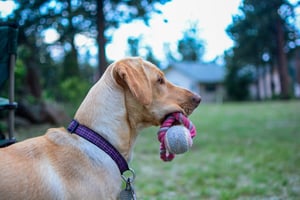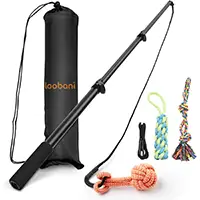 Dogs seem to love putting anything and everything in their mouths, and often they grab items that could be quite dangerous to their health.
Dogs seem to love putting anything and everything in their mouths, and often they grab items that could be quite dangerous to their health.
One training client of mine had a pup that loved to swipe kitchen knives off the counter and run around the yard with them. Yikes!
Drop It is one of the top 6 most important dog training commands that keep your dog safe. You don't want your dog swallowing inappropriate items that could be toxic or cause an obstruction or internal tissue damage.
It's also an important behavior to train because it can help prevent resource guarding, as well as help manage and treat resource guarding behavior. (If your dog guards certain items from you, please contact a certified dog trainer or canine behavior consultant to begin a training program.)
I love training Drop It using play as the main reward, such as a game of tug, fetch, or chasing a flirt pole. This sets you and your dog up to not rely on food treats for such an important and possibly life-saving behavior. Using the game of tug to teach Drop It also helps your dog learn proper play manners and builds their impulse control.
Plus, playing with your dog is an excellent way to build a stronger bond. Further below, you'll learn how to use tug as a training game for Drop It and how to use trades — but you'll also learn another technique perfect for dogs that resource guard or for dogs that aren't all that interested in playing tug or trading.
Drop It is Different Than Leave It
Drop It is used only when a dog already has something in their mouth that you need them to let go of. If they haven't picked up an item yet, and you don't want them to, use the Leave It cue instead.
Clarity in your cues means your dog will have an easier time learning them quickly! Read on to see how easy it is to teach your dog to drop things on cue.
 Myth Buster: You might have heard that playing tug with your dog creates an aggressive or dominant dog — not true! Tug is a wonderful game to burn some of your pup's energy and incorporates important behavior skills, as long as it's played correctly.
Myth Buster: You might have heard that playing tug with your dog creates an aggressive or dominant dog — not true! Tug is a wonderful game to burn some of your pup's energy and incorporates important behavior skills, as long as it's played correctly.However, if your dog already shows signs of resource guarding or overly rough play, it is best to work on those behaviors with a certified dog trainer before incorporating games of tug. Check out this article for more information about how to play tug of war with your dog the right way.
How to Use Tug to Teach Your Dog Drop It
- Grab your designated tug toy and give your dog their start word to initiate the game. I like to use "Get It!" as my dog's start word.
- Once your dog has a good hold on the tug toy, say "Drop it" only once and immediately stop playing. Keep a hold on the toy, and bring your arms in close so the game of tug isn't very exciting or fun for your dog. Your dog might still be trying to tug on it, but you're no longer a part of the game.
- Wait until your dog gets bored of just holding onto the toy and releases the toy from their mouth.
- Once they've let go of the toy, you want to reward them immediately with exciting praise and more play! Give them the start word and toss them the toy or get right back into playing tug.
- Repeat, repeat, repeat! You should see your dog begin to respond more quickly to the Drop It cue.
- When your dog is reliable in dropping their tug toy on cue, you can start transferring this cue to other items. Because you aren't going to be playing tug with anything other than your designated tug toy, let's look at how to make sure your dog generalizes this cue to different items.
Watch this video to see Finnegan, a 9-week-old Portuguese Water Dog puppy, practice Drop It for the first time using tug:
How to Teach Your Dog Drop It with a Treat Lure and Trade
- Grab a few yummy dog training treats. You'll want to practice this cue with appropriate items that your dog already holds in their mouth, such as their stuffed toys, or a chew. If your dog is a resource guarder (aggressively protects their food, toys, etc.), do not use this method unless working closely with a certified dog trainer who can help you address their guarding issues without exacerbating them.
- When your dog is holding a toy or chew in their mouth, put a treat right in front of their nose.
- When your dog drops the item, praise and give the treat as a reward.
- Offer your dog the toy or chew that they just dropped. This way they learn that dropping something when asked doesn't mean that they lose it altogether.
- After your dog has dropped their toy a few times in a row, you're ready to add the verbal cue. Now when your dog is holding the item in their mouth, say the cue “Drop It.”
- Then, present your hand with the treat. Praise when they drop the toy and treat. Repeat until your dog drops the toy on verbal cue only.
Pro Tip: Don't forget to give your dog a chance to drop the object. Wait a second or two after you've given the cue to allow them the opportunity to process what they are learning.
How to Teach Drop It Using Association
This technique is gaining popularity within dog trainer circles, and for good reason! You don't have to start training Drop It only when your dog already has something in their mouth. With this classical conditioning technique, you can start training right away. This technique also doesn't rely on a bribe, which the lure and trade technique above can easily become if you're not careful.
Popularized by world-renowned animal behaviorist Chirag Patel, this method creates a powerful association between hearing the words "Drop It" with something amazing — a treat scatter! — near you. And in the process, your dog begins to spit whatever is in their mouth right out.
This video from Chirag shows the method in action:
How to "Charge" the Drop It Cue
- Have a treat pouch loaded with high-value treats.
- Say "Drop It" and scatter a few of those treats on the ground for your dog. Make sure to point them out for your pup as they find them.
- Wait until your dog finishes with the treats and starts to lose a bit of focus on you.
- Repeat.
- You're looking for an obvious and positive reaction from your dog when they hear "Drop It." At this stage of training, every time you say the cue, there should be a treat scatter.
Begin practicing this cue in different environments when your dog doesn't have anything in their mouth, such as on a leashed walk or in your yard. Don't only practice this in one room of your home. Practice it everywhere!
When your dog is bounding over with joy upon hearing the words "Drop It," you can begin practicing when they have something in their mouth.
- Say "Drop It" and scatter the treats for them.
- Calmly grab the item while they eat the treats on the floor.
- If appropriate, give the item back to your dog after they finish the treats.
As your dog understands the powerful predictive meaning of the words "Drop It," you'll be able to use this cue without the treat scatter happening right afterward. It is helpful to maintain this association and still practice with treat parties every so often.
Other Opportunities to Practice Drop It

Playing Fetch
Playing fetch gives you a wonderful opportunity to practice the Drop It behavior with your pup. It's helpful to get two of the same kind of fetch toy (click here for a list of my favorite fetch toys).
This way you can immediately reward your dog for dropping the first toy by throwing the second. This also gives you time to grab the other toy off the ground in between each repetition.
The idea here is that your dog isn't rewarded with another throw of the toy unless they drop it for you first. If they don't drop their toy when asked, simply say, "oh well!" and turn and walk away, ending the game of fetch. Just like with tug of war, the fun and games only continues if they drop the toy when asked. Dogs catch on to this rule pretty quick!
Playing with a Flirt Pole
Teaching your dog to play with a flirt pole is tons of fun and is a way to burn lots of energy pretty quickly. Drop It is an important cue when using a flirt pole with your dog, and you can use either the treat reward or play reward in this game.
Watch this video of Clover, a Portuguese Water Dog puppy, showing off her Drop It skills while playing with her flirt pole. She even offers a Drop It without being asked, which is rewarded with a treat and then more play! For safety reasons and because she's still working on coming when called, her owner has her on a 30-foot long lead that gives her more freedom to move about in their unfenced yard.
Emergency Drop It Techniques
So what do you do if your dog has nabbed something that could hurt them and you need them to drop it, and they haven't quite mastered the Drop It cue?
First off, don't chase them around in an effort to get it back. Dogs just love to play keep away and chasing after the item increases its value in your dog's mind. Some dogs will even swallow items if they think you're about to take them away, which could cause them to choke or create an obstruction in their digestive tract.
Try one of these Drop It techniques instead:
- Bend down and pretend you've found something ABSOLUTELY AMAZING on the ground. Ooh and aaah over it, maybe even pretend it's something yummy and pretend to eat it. Dogs will often wonder what it is and come over and join you in investigating, dropping the item from their mouth in the process.
- Calmly walk into your kitchen, or whichever room where you store the dog treats or food, and make lots of noise while you open up the bag. Your dog will most likely follow you and know what's happening once they hear that bag crinkle. Once they drop the item, toss the treat or piece of kibble in their food bowl. Quietly reclaim the item while they eat their treat and put it out of their reach.
- Grab one of your dog's toys and make a big deal about playing with it, squeaking it, and tossing it around. Your excitement over the toy should entice your pup to come over and want to play with you, dropping the other item on the way.
If your dog isn't playing keep away, your instinct might be to simply pry open their mouth and take away the item. This technique can be dangerous as it puts you at risk of being bitten, and could make the dog swallow or choke on the item. It can also increase the chance that the dog will become more possessive over items in their mouth in the future — it's a recipe for resource guarding.
However, if it's imperative that the dog doesn't swallow something dangerous, such as a toxic mushroom or piece of sugar-free gum made with xylitol, this could be your best option. Attending a pet first aid class can help you learn the skills needed for this technique.





